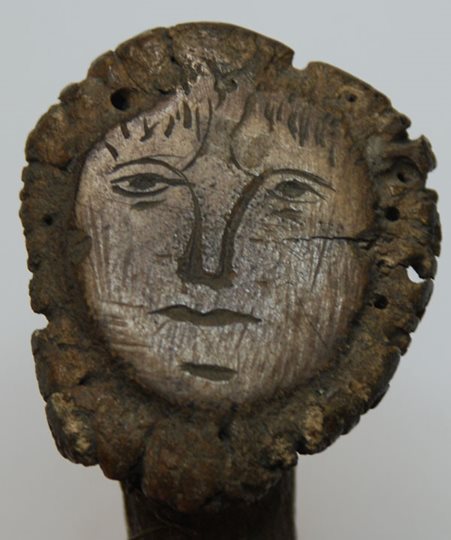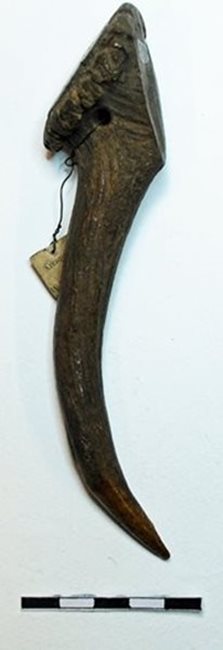Acquired 1881
An Interesting Point
A decorative antler point with potential origins in Viking Dublin
By Donna GilliganDescription
Found amongst a collection of five “Deer Horn Implements” , the original register entry for this object from 1881 reads: “1881:60: Brown, curved and polished at point - a human face rudely engraved on crown, beneath latter is a transverse perforation. Extreme curvilinear length 7 inches. Greatest width of Crown 1 3/4 in.“ The object consists of a section of a worked antler branch known as a tine, with an attached burr at the opposing terminal to the pointed end. Through carving, the antler has been transformed into a decorative anthropomorphic point, and was most likely used as a tool.
The smooth, flat base of the antler burr has been cleverly exploited for use as a surface for an incised line carving of what appears to be a human face, with the expanded edge of the burr forming a decorative surrounding or frame for the face, and providing an impression similar to a lion’s short mane. The carving shows a face with narrow eyes, a long, thin nose, and a solemn, thin-lipped expression, which is exaggerated by two furrows on the forehead which run to the eyebrows and add to the severity of the face. An incised line below the mouth most likely indicates the presence of a cleft in the chin. A number of short vertical lines at the head of the carving suggest the presence of hair on the forehead.

The pointed terminal of the object has been polished, suggesting that this was the end in use by the handler. At the terminal of the pointed tine, there appears to be a small oblique cut which slightly narrows the overall point. A circular transverse perforation located behind the carved burr shows evidence that the object would most likely have been originally suspended or attached to a further piece. In the case of a tool, we could theorise that it may originally have been attached to the user’s belt. This suspension from the back of the head would have allowed the decorated face to point forward, exhibiting the craftsmanship and unusual quality of the object. Examining the raw material of the antler, it can be seen that this fragment from the base of the burr and the brow tine is the result of a natural rupture from a deer.
Antler as a craft material
Antler and bone points of various types are common discoveries on archaeological sites. They are generally believed to have been used as forms of tools, as well as components used during craft and production. These find types are difficult to assign to a tool type with certainty due to their lack of clear association to tasks, as well as due to their simplicity of form. Antler has been in use as a craft material for tools since the prehistoric period, and was very commonly used throughout the medieval period as a robust material for the creation of a wide range of domestic objects. Large-scale antler working areas found at Viking settlement sites like York and Dublin show that naturally shed antler from red deer was gathered in surrounding forests and widely used and traded in towns during the medieval period.Viking age sites commonly produce finds of antler tines, which are sharpened to a point through one or more oblique cuts. Finds comprising of modified antler tines with a pared point, notched side and upper perforation have also been excavated at a number of Viking settlements, such as York, Waterford city, and High Street in Dublin city. Suggestions for these forms of objects have ranged from possible linchpins to stave pegs, to even parts of clamps used in the making of bone and antler combs.
Possible Origins of the object
The uncertain findspot of this object make it difficult to date with certainty. It was donated to the museum by a member of the public with an address at High Street in Dublin city, and a note with the object gives its provenance as “probably Dublin city”. Judging the general appearance and type of object, it can be suggested to be likely of Viking origin. This suggestion appears to be given further credence by the possible discovery of the object in High Street. Excavations in the High Street area of Dublin city were undertaken in the 1960s by Breandán Ó Ríordáin, former Director of the National Museum of Ireland. These excavations uncovered extensive archaeological remains of long-term Viking settlement, with settlement structures and artefacts from this area ranging in date from the ninth to the fourteenth century. The site also produced evidence that showed areas of intensive craft working of bone and antler.

Use of the Object
This object was originally handed into the museum as part of a larger group of five worked antler objects. The four other objects in the group consist of a pin, a pendant, a point and a wedge-shaped tool. Because of their uncertainty of provenance, it is difficult to say whether all five objects would have formed part of an original group. The probable use of at least four of the five objects as a form of craft tool potentially suggests that they may have been part of the same tool set. It could be suggested that this particular object may be a type of awl, a form of pricking tool used for perforation. The polished, pointed terminal, as well as the exterior decoration and perforation, propose the use of the object as a piercing tool which was intended for show as well as function. It may potentially have been used in textile or leather working. Of this specific tool, we can today speculate that viewing the carving means that we may be looking at the representation of a thousand year old face from Viking Dublin.

Learn More
This object is not on display, and is part of the Museum’s Reserve Collections. To see similar objects, you can visit our Viking Ireland gallery at the National Museum of Ireland – Archaeology.
References
McGregor, Arthur, 1985. Bone, Antler, Ivory & Horn: The Technology of Skeletal Materials since the Roman Period. Barnes & Noble Books.
Ó Ríordáin, A.B., 1971. Excavations at High Street and Winetavern Street, Dublin. Medieval Archaeology: 15.
Location:
An Interesting Point is located at:
In Storage
Previous artefact:
Extinct Moa Bird from New Zealand
Next artefact:
